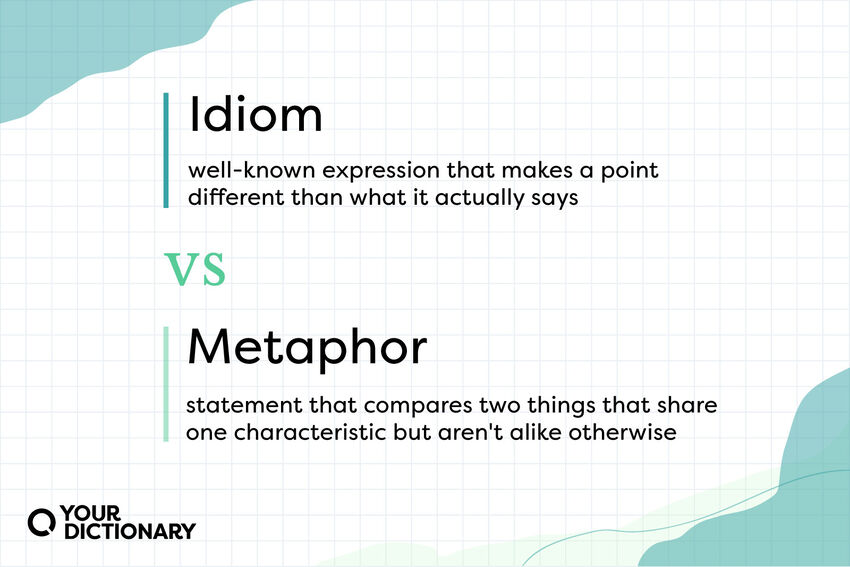
EXAMPLES OF METAPHORS alisen berde
Idioms are phrases or expressions whose meanings aren't directly derived from the individual words within them. Metaphors, conversely, are figures of speech that convey a meaning by drawing a direct comparison between two unrelated things.

Idioms, metaphors and similes
An idiom may have both a figurative and a literal interpretation, whereas a metaphor is a figure of speech that compares one thing to another to illustrate a point. This article will compare an idiom vs. a metaphor and discuss how to use them in writing. What are Idioms and Metaphors?

99+ Common Metaphors with Meanings [Everyday Life] Leverage Edu
But what are idioms and metaphors? What is the difference between them? An idiom is an expression that has a figurative meaning. A metaphor is a figure of speech that refers to one thing by pointing out another for a rhetorical effect. An idiom is a group of repeated words or ideas with a figurative meaning. A metaphor is a figure of speech.

12 Types of Metaphor with Examples Metaphor Vs Simile
Grammar, Language Metaphors and idioms are two of the most commonly used figures of speech. They are often used to make a comparison between things to convey a deeper meaning or to make an abstract concept more understandable. But what's the difference between these two types of figurative language?

Metaphors and idioms online presentation
An idiom is a group of words established by usage as having a meaning not deducible from those of the individual words (Examples: barking up the wrong tree, once in a blue moon, see the light ). A metaphor is an expression representative or symbolic of something else, especially something abstract. (Example: "He broke my heart.".

Idiom vs. Metaphor How to Recognize the Difference YourDictionary
Simile: A simile, like a metaphor, makes a comparison between two unrelated things. However, instead of stating that one thing is another thing (as in metaphor),. Idiom: An idiom is a phrase that, through general usage within a particular group or society, has gained a meaning that is different from the literal meaning of the words. The.

Teaching Similes & Metaphors to Kids Teaching Resource
By definition, idioms are not. Metaphors are not logical, but they can be compositional in context, since once the contextual metaphor theme is chosen, the metaphoric meanings of its parts and their syntactic rules become arguments of the compositional function. There are lots of sub-regularities in idioms and metaphors, too, which are worth.

Anchor Chart For Similes And Metaphors Online Shopping
Idioms, conceived as fixed multi-word expressions that conceptually encode non-compositional meaning, are linguistic units that raise a number of questions relevant in the study of language and mind (e.g., whether they are stored in the lexicon or in memory, whether they have internal or external syntax similar to other expressions of the langua.

Metaphors and Idioms Teaching, Teaching writing, Expository writing
The difference between idioms and metaphors is that metaphors use implied comparisons to create meaning whereas idioms are instinctively understood by the language user without having to use implied comparison to deduce the meaning. In fact, the original meaning is often not logically deducible. That's tough, so let's break it down:

What Does A Metaphor Mean MEANID
The main difference between idioms and metaphors is that idioms are used to make a point, while metaphors are used to make a comparison. An idiom is an expression that cannot be taken literally, such as "it's raining cats and dogs." A metaphor is a figure of speech that uses one thing to represent another, such as "the world is my oyster."

Metaphor vs Similes vs Idiom Similes and metaphors, Simile, Idioms
In the Western tradition, many phrases and terms from the Bible are utilized as allegory, metaphors, idioms, or simply to describe the characteristics of a known person or event. They have become an essential element of literature and descriptions of everyday life situations. Here is a list of the more popular references. Tyndale Bible

Wordle Metaphors Idioms WORDLESB
The Britannica Dictionary Ask the Editor Idioms, metaphors, similes, and hyperbole Question What is the difference between idioms and figures of speech like similes, metaphors, and hyperbole? — Kenneth, Philippines Answer Readers often ask about these terms. Here are some simple explanations. Idioms

Metaphors Making Vivid Comparisons Curvebreakers
Vocabulary Idioms & Figures of Speech Idiom vs. Metaphor: How to Recognize the Difference By Jennifer Gunner, M.Ed. Education , Senior Writer Updated May 23, 2022 Image Credits Idioms and metaphors are both ways to express an idea figuratively rather than literally. But are they the same thing? Can a phrase be both a metaphor and an idiom?

22 Useful Daily Routines Idioms And Expressions 7 E S L Idioms
8. Go cold turkey. To go cold turkey means to suddenly stop a (usually dangerous) behavior, such as drinking alcohol. A person who suddenly quits something addictive can suffer from pale skin and goosebumps, making them look like a cold, uncooked turkey. I quit smoking cold turkey and never felt the need to go back.

Metaphors, Similes and Idioms Scoop.it
Psychology Writing Center [email protected] http://www.psych.uw.edu/psych.php#p=339 Idioms and Metaphors Sometimes readers will come across idioms and metaphors in scientific writing. Idioms have figurative meanings that are different from their literal meanings.

Metaphors and idioms online presentation
2. Hungry as a Bear Meaning: Extremely hungry, likening to the appetite of a bear preparing for hibernation. In a Sentence: Skipping breakfast made me as hungry as a bear, raiding the pantry for anything edible. 3. Hungry as a Shark Meaning: Intensely and urgently hungry, comparable to the predatory hunger of a shark.